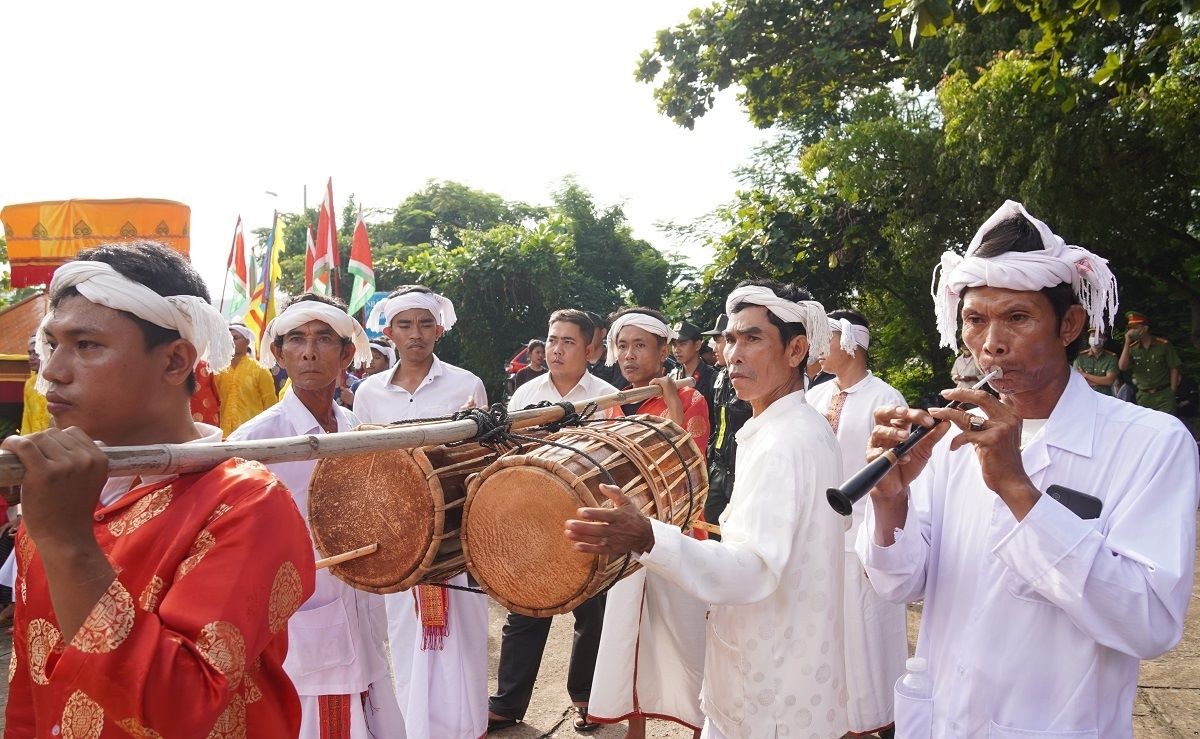
Music of Cham people - Identity and interference
Latest
 |
| Music is always attached to the Cham people’s festivals. (Photo: Baodantoc.vn) |
Just like other ethnic groups in our country, for the Cham people, music is always associated with life and many daily activities. However, when most people hear about Cham music, they often immediately refer to ceremonial music, since this is the most popular type.
It cannot be denied that every bustling music and graceful dance during festivals are filled with the rich spiritual life of the Cham people.
Priest Ca Chuan, living in Ma Lam town, Ham Thuan Bac (Binh Thuan province) - a Cham Brahman religious dignitary, specializing in leading ceremonies, said: “Each deity or each type of worship and sacrifice has its own songs or supporting music. Musical instruments are the same, in each festival, there will be musical instruments used as “commanders”. For instance, during the peace offering ceremony, only the Priest can play the Paranung drum, which is the first lead and is followed by the other drums”.
Mentioning the music employed in festivals of the Cham people, it is impossible not to mention the typical musical instruments, which have become prominent through musical and poetic works, such as: Paranung drums, Ginang drums, and Saranai trumpets.
According to musician Le Hung Tien (Ninh Thuan province), who has devoted a lot of effort to collecting and researching Cham folk music, said: The Cham people’s traditional musical instruments are abundant but can basically be divided into three main genres: percussion, woodwinds, and strings. The most typical percussion instruments are the Paranung and Ginang drums, which play a crucial role in ceremonies. Regarding the woodwinds, Saranai trumpet is also an instrument present in most folk ceremonies.
In general, apart from a few specific types of musical instruments, there are also musical instruments that originated from diverse cultural interaction, such as the Hagar Paong (big drums) similar to the Kinh people’s praise drum, the Ceng drums, which is a brass musical instrument, similar to the gongs of ethnic groups in the Central Highlands, or the Kanyi, a string instrument with a structure similar to the Nhi (Vietnamese 2-chord fiddle).
Besides musical instruments, Cham folk songs are also a rich field with various genres, from love, “challenge-and-response”, rice grinding, rice pounding, quiz, to funeral songs (lulling the souls of the deceased before cremation). However, the most recognized thing about Cham folk songs is their purity, excitement and lyricism. The relaxed, earnest melody makes listeners easily refer to the Ly tunes in the Central region, such as Ly Hoai Nam (Remembering the South), Ly Con Sao, Ly Thien Thai, or the faint “smell” of Southern Vong co with the melodies of “ho mai nhi” and “ho mai day” (Barcarolle – boatwomen’s songs in Hue).
Artist Ba Sinh Ty, in charge of the Cham Folk Music Band at Po Sah Inu Tower (Phan Thiet, Binh Thuan province) said: The Cham folk music treasure is plentiful, depending on the characteristic of the festival or the purpose of the performance, there will be different songs. However, nowadays, in order to easily reach listeners, who are people of other ethnic groups and tourists, many Cham folk songs have been translated or written into Vietnamese lyrics.
“New songs have been composed, based on or influenced by folk songs and that is also the inevitable development trend of culture in modern time”, Artist Ba Sinh Ty added.
In one of his studies, the late musician Pham Duy once identified the characteristics of the Cham people’s musical language, which includes elements combining the scales of the pentatonic system of Northern music, with the melody of bai Choi singing in the Central region and also the Southern melody of Southern folk songs. Thus, there have been meeting points in the music field of the Cham people and other ethnic groups stretching from the Central region to the South. It is the result of natural and voluntary cultural exchange and enrichment between peoples through a long history until today.
However, like many other ethnic groups in our country, the development of modern life along with the introduction of culture through various types of technology, the preservation and promotion of traditional values, including music. Although the government, all levels, and sectors have paid attention and offered solutions, music still seems to have gaps in inheritance. If there is no fundamental and quick solution in preserving and promoting, the Cham ethnic musical heritage will die down.
Generations of artisans who know how to make musical instruments, know traditional music songs by heart, and know how to use traditional musical instruments are getting older, at the same time, it is difficult to find dedicated people to hand them down. Like the concerns of artisan Lo Phu Bao (Ninh Thuan province): “We hope that besides us, there will be many young people standing and beating drums, and singing at the foot of the Po Sah Inu Cham Tower. We are just afraid that they refuse to learn and inherit since we are always ready to teach with all our hearts”.

















